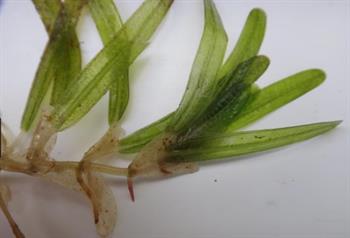


Seagrasses are monocot plants and are the only flowerIng plants (angiosperms) found in Antiguan Waters. Halophila stipulacea (formerly is a seagrass native to the Indian Ocean that spread into the Mediterranean after the opening of the Suez Canal. Subsequently it has spread to the Caribbean and has been rported in Antigua.
It grows in sandy, muddy, or coral rubble substrate as shallow as a few centimeters down to depths of over 30 meters. It can grow in small patches of less than 1 meter (3 feet) in diameter to extensive meadows of many hectares. It may be found growing alone or mixed with native Caribbean seagrasses and there is a risk that it could outcompete native seagrasses (e.g. Turtle Grass Thalassia testudinum) and dominate that ecosystem.
Identifying H. stipulaea compared to native seagrasses:
The leaves/blades of H. stipulacea are typically between 2cm and 8cm (1-3 inches) in length and approximately 1cm wide (1/2 inch). Blades are elliptic or oblong in shape, medium to dark green in color, and grow in clusters of 2 to 6 blades coming from a single shoot in the sand. Multiple shoots are linked by a horizontal root-structure called a rhizome.
Looking closely at a single blade, the tip and lateral edges will be serrated (bordered by little teeth) . A mid-rib vein will stretch from the tip of the blade to the base with pairs of 6 or more cross-veins extending at a 45-60 degree angle from the center mid-rib to the blade margins
It grows in sandy, muddy, or coral rubble substrate as shallow as a few centimeters down to depths of over 30 meters. It can grow in small patches of less than 1 meter (3 feet) in diameter to extensive meadows of many hectares. It may be found growing alone or mixed with native Caribbean seagrasses and there is a risk that it could outcompete native seagrasses (e.g. Turtle Grass Thalassia testudinum) and dominate that ecosystem.
Identifying H. stipulaea compared to native seagrasses:
The leaves/blades of H. stipulacea are typically between 2cm and 8cm (1-3 inches) in length and approximately 1cm wide (1/2 inch). Blades are elliptic or oblong in shape, medium to dark green in color, and grow in clusters of 2 to 6 blades coming from a single shoot in the sand. Multiple shoots are linked by a horizontal root-structure called a rhizome.
Looking closely at a single blade, the tip and lateral edges will be serrated (bordered by little teeth) . A mid-rib vein will stretch from the tip of the blade to the base with pairs of 6 or more cross-veins extending at a 45-60 degree angle from the center mid-rib to the blade margins
Click image for larger size
A Seagrass - Halophila stipulacea
